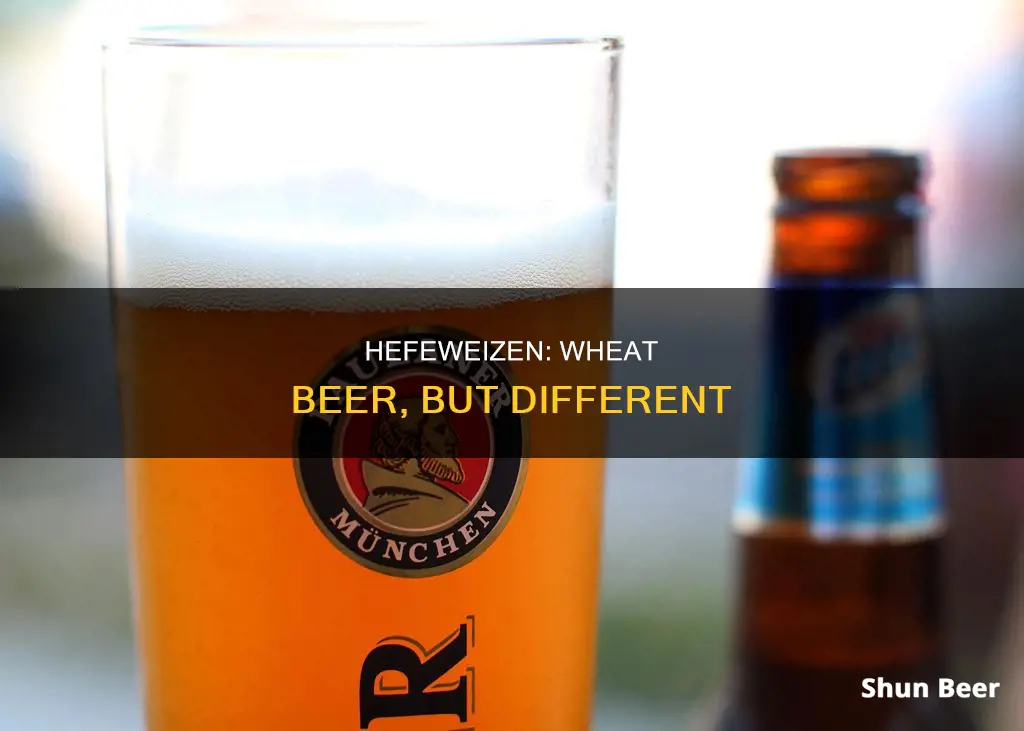
Wheat beer is a top-fermented beer brewed with a large proportion of wheat. Hefeweizen, a German-style wheat beer, is a type of weissbier (white beer in German). It originated in Bavaria in the 16th century and is made with a significant proportion of wheat malt. Hefeweizen is characterised by its banana and clove aroma and flavour notes, resulting from the use of a specific yeast strain. It has a cloudy, golden appearance and a thick foamy head. While hefeweizen is a type of wheat beer, it differs from other wheat beers in its use of specific ingredients and brewing techniques, resulting in its unique flavour profile and appearance.
| Characteristics | Values |
|---|---|
| Origin | Germany |
| Translation | "Yeast Wheat" |
| Main Ingredients | Wheat, Yeast |
| Wheat Content | 50-65% |
| Appearance | Cloudy, Golden, White Foam |
| Flavour | Banana, Clove, Bubblegum, Black Pepper |
| ABV | 4.0-7.0% |
What You'll Learn

Hefeweizen's German origins
Hefeweizen is a type of German wheat beer, or "weissbier" ("white beer"), that originated in the breweries of Bavaria, Germany, in the 1520s. The name comes from the German words "hefe", meaning yeast, and "weizen", meaning wheat.
At the time of its creation, German regulations did not allow the beer to flourish. In 1487, Germany proposed the Reinheitsgebot, or Purity Law, which stated that the only allowable ingredients in making beer were barley, hops, and water. Yeast, a main ingredient in hefeweizens, was not mentioned.
The Dukes of Wittelsbach, rulers of Bavaria and lovers of weizenbier, created a loophole called the Weissbierregal, or the "right to brew wheat beer". In 1520, they decreed that a single brewery in the village of Schwarzach, run by the Dukes of Degenberg, would be allowed to brew weizenbier.
The Degenbergs were the sole brewers of weizenbier and hefeweizens until 1602, when the final Duke of Degenberg died without an heir, and all the family's assets passed to the ruling Wittelbachs. Duke Maximilian I believed that weizenbier had economic potential, so he expanded production to more breweries in Bavaria.
Hefeweizen is typically straw to amber in colour and brewed with at least 50% malted wheat. The aroma and flavour come largely from the yeast and are fruity (banana) and phenolic (clove). The intensity of these flavour qualities varies depending on the brewer, but the two are most commonly balanced.
Hefeweizens are highly carbonated and typically contain a low to moderate alcohol content. They are best served in a weizen glass, which is specifically designed with a wide rim and narrow base to allow the highly carbonated beer to form a medium-thick head that accentuates the yeast flavours.
Wheat Beer: What's the Deal?
You may want to see also

Hefeweizen's flavour profile
Hefeweizen is a type of wheat beer, with a distinctive flavour profile. The German name, "Hefeweizen", translates to "'yeast wheat", and the wheat content is responsible for the beer's characteristic fluffy head of foam. The beer is also unfiltered, which gives it a cloudy appearance.
The flavour profile of Hefeweizen is largely determined by the type of yeast used. The yeast adds banana, clove, bubblegum, and even black pepper aromas and notes to the beer. The banana flavour is particularly prominent, with some describing it as "ripe banana" or "overripe banana". The yeast also gives the beer a bready, bright, lemony character, and a "bubblegum spice flavour". The banana and clove flavours are created by the Bavarian yeast strains used to ferment the beer. The specific yeast strain used is Torulaspora delbrueckii, which imparts classic Hefeweizen flavours.
The other ingredients used in brewing also contribute to the flavour profile. The high wheat content, for example, gives the beer a bready, bright wheat character. The beer is also often described as having a malty, bready, or malty-bready flavour, with hints of caramel. The hops used are not very noticeable in the flavour profile, especially bitterness. However, some describe the beer as having a "pure, clean note of toasted wheat" and "spicy and earthy Noble hop notes".
The combination of these ingredients and the brewing process gives Hefeweizen a distinctive flavour profile that is well-loved by beer enthusiasts.
Beer and Wheat: What's the Connection?
You may want to see also

Hefeweizen's brewing process
Brewing a Hefeweizen is a complex process that requires precision and attention to detail. Here is a step-by-step guide on how to brew this German wheat beer:
Ingredients
The grain bill for a Hefeweizen typically consists of a 60/40 split between wheat malt and pilsner malt, respectively. Some brewers may also add a small proportion of Munich malt to enhance the toasty, bready character of the beer. It is important to note that wheat malt does not have the husk that malted barley does, so adding rice hulls is recommended to prevent a stuck mash. The hops used are typically German noble hops, such as Hallertau Mittelfruh, but other options include Liberty, Mt. Hood, or Tradition.
Mashing
The mashing process for a Hefeweizen is crucial and can be quite complex. The traditional method is a double-decoction mash, which involves multiple rests at specific temperatures. The first rest is a ferulic acid rest at around 113°F (45°C), which helps create the spicy clove flavors characteristic of Hefeweizen. This is followed by a protein rest at 147.2°F (64°C) and a saccharification rest at 162°F (~72°C). For brewers who don't have the equipment for decoction mashing, a step mash can be performed, targeting similar temperature ranges.
Boiling
The wort is then boiled for 90 minutes, with hops added at the 60-minute mark. A yeast nutrient may also be added at the 10-minute mark. After boiling, the wort is whirlpooled and allowed to wind down before cooling.
Fermentation
Fermentation is a critical step in the Hefeweizen brewing process, as it is during this stage that the distinctive banana and clove flavors are developed. The yeast strain chosen should be a non-flocculant, POF+ (produces phenolic off-flavors) strain, such as Weihenstephan Weizen or Hefeweizen Ale Yeast. The fermentation temperature is typically around 62°F (17°C), and open fermentation is often used, as it increases phenol and ester production. Underpitching the yeast is a common technique to stress it and enhance ester formation, but this should be done with caution.
Conditioning and Packaging
After fermentation, the beer is cold crashed and then transferred to a brite tank for carbonation. Bottling or kegging can then be performed, with a target carbonation level of 2.5 to 3.5 volumes. Conditioning takes about 3 weeks, with rests at different temperatures to reduce diacetyl and enhance flavor development.
Brewing a Hefeweizen is a complex and rewarding process that requires attention to detail and a good understanding of brewing techniques. The resulting beer is a refreshing, cloudy wheat beer with distinctive banana and clove flavors and a fluffy mouthfeel.
Blue Moon Beer: Wheat or Not?
You may want to see also

Hefeweizen's history
Hefeweizen is a style of wheat beer that originated in Germany. The name, pronounced HAY-fuh-vites-in, means "yeast wheat" in German. The practice of making beer using wheat in Germany is thought to date back to the 11th century.
The Germanic tribes began brewing much paler ales in the Middle Ages. Wheat grain and barley were abundant resources, and the use of both to brew one beer brought about the inception of Weissbier, or "white beer". These beers were so much lighter than traditional dark beers that the term "white beer" became a common naming convention.
In the 1500s, wheat beer in the region of Bavaria was brewed by the ruling clan of Degenberger. They became the only legal producers and monopolized this good fortune by decreeing that no other brewer could do so without first gaining their permission in the form of a royal license. When the current duke of the Degenberger line, Sigismund, died without producing an heir, the royal license reverted to the Bavarian house of Dukes, namely Duke Maximilian I.
Maximilian wanted to extend the license to cover all his lands, including arrangements for the first Weiss brewery in Munich. It is unclear whether this construction took place under Maximilian's reign or his predecessor, Duke William IV. What is clear is that this was only one of many Weiss breweries operated under royal license during the next two centuries.
The 1800s saw a decline in the popularity of Weissbier, culminating in the closing of many breweries. In 1812, only two breweries in Bavaria were still making the style. With this decline, the crown relinquished control of the license, and the brewing of Weissbier was once again open to the public.
Many breweries began to brew wheat ales on a small scale alongside their more popular lagers, but it was a single brewer named Georg Schneider who was instrumental in bringing wheat ales back. He bought an old brewery in Munich and was able to triple its output over a few years. The brewery is still run by the Schneider family today.
Hefeweizen, or "yeast wheat", is an unfiltered ale, meaning the brewer's yeast is left in suspension, making the beer cloudy and slightly white-looking. It is a refreshing, highly carbonated beer ideal for quenching summer thirsts. The yeast strains used in traditional hefeweizens can impart flavours of spicy cloves, banana, bubblegum, or citrus. The alcohol content is typically between 5% and 5.5%.

Hefeweizen vs. American Wheat Beer
Hefeweizen and American Wheat Beer are both wheat beers, but they differ in several ways.
Hefeweizen, or "yeast wheat" in German, is a type of weissbier that originated in Bavaria, Germany, in the 1520s. It is brewed with a large proportion of wheat (50-60%) and is characterised by its banana and clove flavours and aromas, which come from the Bavarian yeast strains used in fermentation. Hefeweizens may also have hints of vanilla or bubblegum. They are typically cloudy and slightly white in appearance, with a thick head of white foam. Hefeweizens usually have an ABV of between 4.0 and 7.0%.
American Wheat Beer, on the other hand, uses clean, neutral American ale yeast or lager yeast, resulting in a less fruity flavour profile. These beers usually contain about 30% malted wheat, with the rest being pale 2-row malt. They have a bready, doughy, or cracker-like taste and a straw-yellow to golden hue. American Wheat Beers are typically crisp and highly drinkable, with an ABV ranging from 4.0 to 5.5%.
In terms of appearance, American Wheat Beers can be relatively clear or cloudy, while Hefeweizens are always cloudy. American Wheat Beers also tend to have a more noticeable hop character, resulting in a crisp texture when compared to Hefeweizen.
While Hefeweizens are traditionally brewed with a simple grain bill and low IBUs, American Wheat Beers often use more hops and different malts, allowing for more freedom and flexibility in the brewing process.
It is worth noting that some American breweries, such as Widmer Bros., have labelled their American Wheat Beers as Hefeweizens, which can be confusing for consumers as the two styles have distinct flavour profiles.
Frequently asked questions
Hefeweizen is a German-style wheat beer, with "Hefe" meaning "yeast" and "weizen" translating to "wheat" in German. It is an unfiltered wheat beer with yeast in it and features up to 50-65% wheat in the mash.
Hefeweizens are known for their banana, clove, vanilla, bubblegum, and even black pepper flavours and aromas. They are easy-drinking, refreshing beers.
Hefeweizen originated in the 1520s in Bavaria, Germany. It was brought to America by German immigrants in the 19th century and became popular with craft brewers in the 1980s.
Witbiers, also known as white beers, were brewed in Belgian monasteries as early as the 14th century and feature spices such as coriander and citrus notes. Hefeweizens, on the other hand, are German wheat beers that typically have banana and clove flavours and a thick foamy head.
American Wheat Beers were inspired by the fruit and spice-forward, unfiltered wheat beers of Bavaria but used American ale and lager yeast, removing the banana and clove flavours. They typically have a bready, doughy, or cracker-like taste and are less bitter than Hefeweizens.







